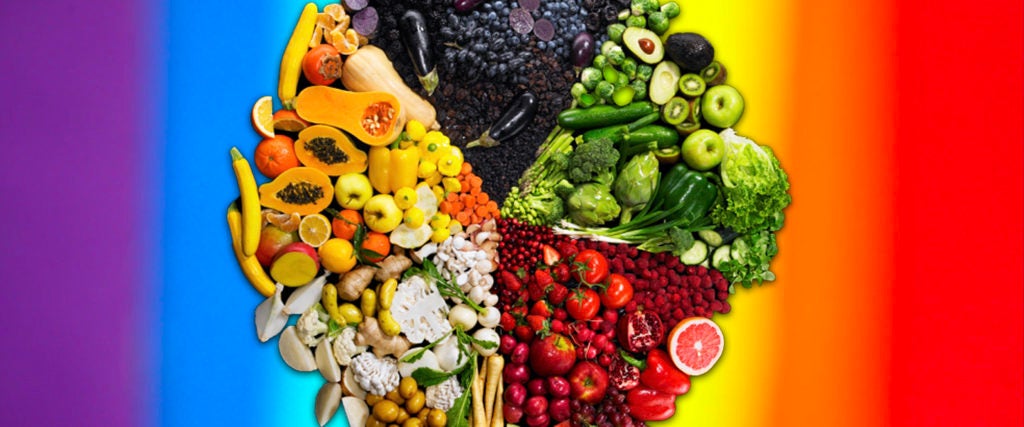I recently hit up the doctor for my annual checkup and a battery of blood tests. When the results came back, all my doctor could do was congratulate me. “Wow! You have the blood of an 18-year-old,” he told me. “Whatever your health practices are, keep them up.”
It’s funny, because as I’d told him during the exam, I drink regularly, I smoke pot daily and I only stopped smoking cigarettes within the last year. But I am a health nut about one thing: I eat my colors every day.
Yes, I recognize this sounds like something a toddler would tell you after they consumed a handful of crayons. But I swear, “eat your colors” is the rare health/diet advice that can actually give you everything you’re missing.
It’s easy, too: Just think of a color wheel. There are primary colors (red, blue and yellow) and then secondary colors (violet, orange and green). The trick is to eat at least five of those colors every day.
Now, “eating your colors” excludes processed foods — i.e., a plateful of potato chips doesn’t count as hitting your daily requirement of yellow, and sweet potato fries don’t count as eating a “red.” I’m only talking about fruits and vegetables. (Researchers recommend you eat 9 to 14 servings of them a day, with the latest U.S. Dietary Guidelines defining a serving as “2 1/2 cups of vegetables and 2 cups of fruit, based on a 2,000-calorie diet”). What you’re particularly after are phytonutrients — namely, antioxidants, carotenoids, flavonoids, flavones, isoflavones, phytochemicals, polyphenols, anthocyanins and isothiocyanates, catechins, allyl sulfides and a bunch of other stuff that’s equally hard to pronounce.
The thing is, they’re often located in areas that get discarded when fruits and veggies are processed (e.g., fruit skins). Thus, as Harvard Health suggests, “Try to avoid peeling foods like apples, peaches and eggplant, lest you lose their most concentrated source of beneficial chemicals.” Along these lines, try to eat them as raw as possible, too.
As for which fruits and veggies you should be eating, the American Heart Association has made this handy infographic:

But allow me to take it color by color for you as well…
Red
Fruits/Veggies: Tomatoes, strawberries, red bell pepper, raspberries, cherries, beets, cranberries, red onions, red grapes, watermelon, ruby red grapefruit, rhubarb and red apples
What It Brings to the Table: Vitamin A, vitamin C, beta-carotene and lycopene
The (Healthy) Tasting Notes: Vitamin C is typically associated with oranges and other citrus fruit. But a red bell pepper flexes on the orange when it comes to vitamin C — an average of 95 milligrams to an average of around 70 milligrams. If you don’t like bell peppers, strawberries (85 milligrams) also offer more vitamin C than oranges.
Lycopene is a powerful antioxidant that protects the health of your lungs and heart. Interestingly, it’s best absorbed after cooking it and with the addition of fat. That means pizza — or better put, pizza sauce — can be a healthy food if prepared correctly. That said, watermelon has even more lycopene than tomatoes.
Orange/Yellow
Fruits/Veggies: Carrots, corn, pumpkins, sweet potatoes/yams, cantaloupe, acorn/butternut squash, bananas, pineapple, peaches, apricots, nectarines, tangerines and oranges
What It Brings to the Table: Vitamin C, potassium and betra cryptothanxin
The (Healthy) Tasting Notes: Beta cryptothanxin benefits intracellular communication. As an antioxidant, it’s “associated with decreased risk of some cancers and degenerative diseases.” Potassium is an overlooked and typically deficient nutrient that’s key to overall body functioning. In fact, all of your body’s bioelectrical action depends on a sodium-potassium interaction.

Green/Dark Green
Fruits/Veggies: Broccoli, Brussel sprouts, bok choy, artichokes, asparagus, okra, avocado, cabbage, green beans, celery, kiwi, collard greens, kale, limes, pears, spinach, mustard greens, sprouts, snap peas and zucchini
What It Brings to the Table: Vitamin K, lutein, isoflavones, isothiocyanates and key minerals like iron
The (Healthy) Tasting Notes: Iron is a vital mineral, important for blood and bones, and leafy greens are a good source of it, which can be important if you don’t eat meat. When it comes to vitamins, there are a ton of phytonutrients you can draw from green fruits and veggies. For instance, kale offers as much, if not more, calcium than a glass of milk or cup of yogurt. Meanwhile, broccoli is believed to be an important source of cancer-fighting compounds such as isocyanate and sulforaphane.
Blue/Indigo/Violet
Fruits/Veggies: Eggplant, blueberries, boysenberries, marionberries, blackberries, elderberries, grapes, raisins, purple cabbage, prunes, plums, figs and black currants
What It Brings to the Table: Vitamin C and anthocyanin
The (Healthy) Tasting Notes: Eggplant has been credited with reducing oxidative stress on cells, which can lead to inflammation, which can lead to cancer, heart disease and Parkinson’s. Basically then, you can think of blue fruits as life extenders.
White/Brown
Fruits/Veggies: Bananas, shallots, onions, garlic, mushrooms, cauliflower, parsnips and potatoes
What It Brings to the Table: B vitamins, iron, potassium, glucosinolates and polyphenols
The (Healthy) Tasting Notes: While white isn’t technically a color, I’m making an exception because it offers so many phytonutrients. There’s the glucosinolates found in turnips, as well as the polyphenols in garlic and onions. For their part, brown foods (a la potatoes) are a good source of vitamin C, iron and B1, B3 and B6 vitamins, while mushrooms are a great source for magnesium, copper, potassium and zinc.
I’m telling ya — make your plate look like a rainbow, and you’ll have the blood levels of an 18-year-old, too.

